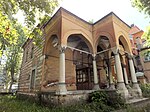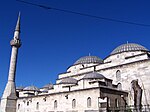Forum of Constantine

The Forum of Constantine (Greek: Φόρος Κωνσταντίνου) was built at the foundation of Constantinople immediately outside the old city walls of Byzantium. It marked the centre of the new city, and was a central point along the Mese, the main ceremonial road through the city. It was circular and had two monumental gates to the east and west. The Column of Constantine, which still stands upright and is known today in Turkish as Çemberlitaş, was erected in the centre of the square. The column was originally crowned with a statue of Constantine I (3. 306-337) as Apollo, but a strong gale in 1150 caused the statue and three of the column's upper drums to fall, and a cross was added in its place by the Byzantine emperor Manuel I Komnenos (r. 1143-1180). Otherwise the forum remained nearly intact until the Fourth Crusade in 1203–1204. The city's first Senate House lay on the north side of it. We know from the sources that the square was decorated with a number of antique statues, but it is impossible to determine their exact appearance and location. The Forum suffered major damage in a fire started by soldiers of the Fourth Crusade in 1203. After the Sack of 1204, the antique statues decorating the Forum were melted down by the Crusaders.
Excerpt from the Wikipedia article Forum of Constantine (License: CC BY-SA 3.0, Authors, Images).Forum of Constantine
Vezirhanı Caddesi, Istanbul
Geographical coordinates (GPS) Address Nearby Places Show on map
Geographical coordinates (GPS)
| Latitude | Longitude |
|---|---|
| N 41.009 ° | E 28.971 ° |
Address
Çemberlitaş Otopark
Vezirhanı Caddesi
34120 Istanbul
Türkiye
Open on Google Maps











